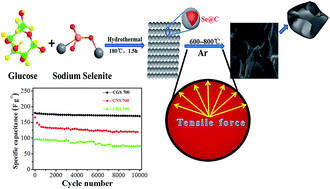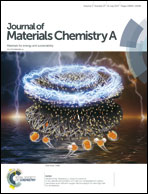Tensile force-induced tearing and collapse of ultrathin carbon shells to surface-wrinkled grape skins for high performance supercapacitor electrodes†
Abstract
With glucose as a highly accessible carbon source, mesoporous carbon nano grape skins were successfully fabricated via a facile template-based hydrothermal method and subsequent tensile force-induced tearing and collapse. The resulting carbon nano grape skins possess a novel structure as a nanosheet rolled up from the around, which maintains the ultrathin properties of the nanosheets. However, unlike carbon nanosheets, which are prone to aggregation or restacking, the carbon nano grape skins were separated from each other due to the crimp force induced by the rolled side. The largest specific surface area of 1570.9 m2 g−1 and the total pore volume of 2.429 m3 g−1 were achieved for the product obtained at 600 °C. Compared to carbon nanosheets and carbon hollow spheres obtained at 700 °C, the products obtained at 700 °C, when used as electrode materials for supercapacitors, showed a much higher specific capacitance of 268 F g−1 at 0.1 A g−1, a higher rate specific capacitance of 170 F g−1 at 10 A g−1, and better cycling stability with 94.2% capacitance retention after 10 000 cycles at 2 A g−1 in a two-electrode system.



 Please wait while we load your content...
Please wait while we load your content...